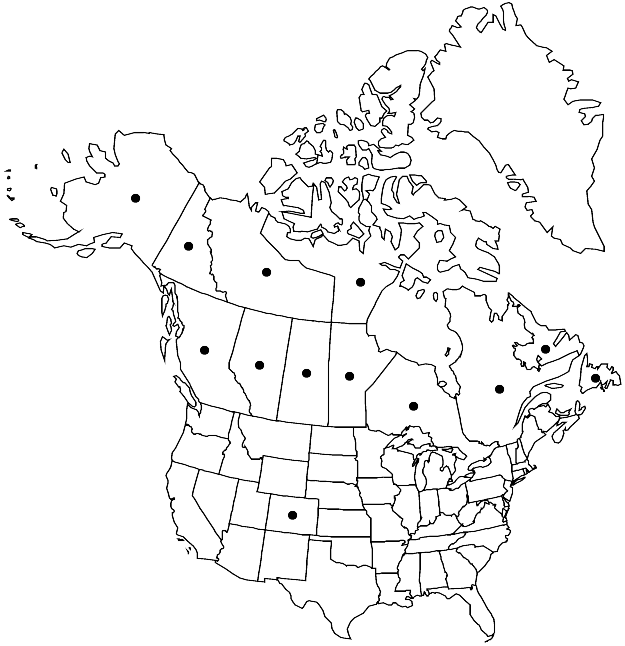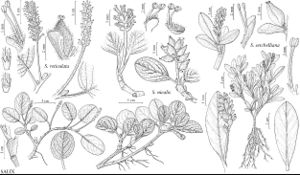Salix reticulata
Sp. Pl. 2: 1018. 1753.
Plants 0.03–0.15 m, (dwarf, forming clones by layering). Stems trailing; branches and branchlets yellow-brown or red-brown, glabrous. Leaves: stipules absent or rudimentary; petiole 3–46 mm, (sometimes glandular distally); largest medial blade amphistomatous or hemiamphistomatous, (2 pairs of secondary veins arising at or close to base, arcing toward apex), oblong, broadly oblong, broadly elliptic, subcircular, or circular, (8–)12–66 × 8–50 mm, 1–1.5 times as long as wide, base convex, rounded, subcordate, or cordate, margins slightly revolute, entire or crenulate (glandular-dotted), apex rounded, convex, or retuse, abaxial surface sparsely long-silky to glabrescent, adaxial (venation deeply impressed), slightly or highly glossy, glabrous or pilose; proximal blade margins entire; juvenile blade glabrous. Catkins: staminate 11–54 × 4–9 mm, flowering branchlet 2–28 mm; pistillate densely flowered (more than 6 flowers), slender or stout, 11–79 × 3–8 mm, flowering branchlet 2–37 mm; floral bract tawny, 0.8–1.8 mm, apex rounded to retuse, entire, abaxially glabrous. Staminate flowers: abaxial nectary 0.5–0.9 mm, adaxial nectary oblong or ovate, 0.5–1 mm, nectaries connate and cup-shaped; filaments distinct, hairy on proximal 1/2 or throughout; anthers ellipsoid or globose, 0.3–0.4 mm. Pistillate flowers: abaxial nectary (0–)0.3–0.5 mm, adaxial nectary narrowly oblong, 0.5–1 mm, equal to or longer than stipe, nectaries distinct or connate and cup-shaped; stipe 0–0.8 mm; ovary pyriform or ovoid, short-silky, hairs flattened, beak abruptly tapering to styles; ovules 8–18 per ovary; styles connate to distinct 1/2 their lengths, 0.2–0.3 mm; stigmas flat, abaxially non-papillate with rounded tip, broadly cylindrical, or 2 plump lobes, 0.2–0.26–0.36 mm. Capsules 4.5–5 mm. 2n = 38.
Phenology: Flowering early Jun-mid Aug.
Habitat: Arctic-alpine, polygonal tundra, dry tussock tundra, partially stabilized sand dunes, sedge meadows, Dryas tundra on alpine cliffs and ledges, snowbeds, stabilized talus slopes, white spruce woods, treed bogs
Elevation: 0-3500 m
Distribution

Alta., B.C., Man., Nfld. and Labr., N.W.T., Nunavut, Ont., Que., Sask., Yukon, Alaska, Colo., Europe, Asia (Chukotka, Russian Far East, arctic, e Siberia, Spitzbergen).
Discussion
The reported occurrence of Salix reticulata in Colorado (R. D. Dorn 1997) needs further study.
Salix reticulata occurs in Europe in northern Scotland, northern Scandinavia, the Alps and other European mountains, and arctic Eurasia. The species is circumpolar except for Greenland and Iceland.
A population of Salix reticulata on the Queen Charlotte Islands, with consistently glabrous ovaries, was named subsp. glabellicarpa. Some southeastern Alaska populations have plants with glabrous, partially hairy, and completely short-silky ovaries growing together. The possibility that subsp. glabellicarpa may be a hybrid or a simple mutation needs study.
Selected References
None.
